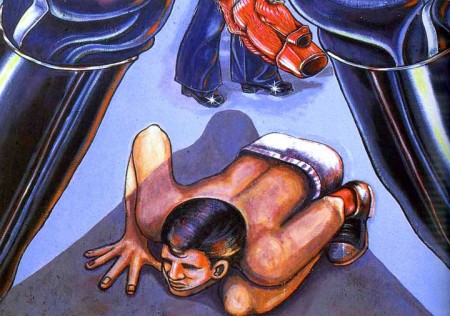“The Sleepy Lagoon murder” of a young Mexican-American man ignited ethnic and racial tensions that lead to riots in Los Angeles.

"Zoot Suit Riots," mural by Judy Baca, 1981, San Fernando, California.“La Rebelión Zoot Suit,” mural de Judy Baca, 1981, San Fernando, California.
In response to the murder in August 1942, the Los Angeles police conducted sweeps detaining 600 Mexican American youths. A young “zoot-suiter” named Hank Leyvas was one of a total of sixteen defendants who were found guilty. The verdict sparked a series of brutal riots in 1943. Although years later the convictions were overturned, the legacy of injustice would have a lasting impact on Los Angeles and the youth of the barrios.
Initially an African American youth fashion, the ”zoot suit“ was an oversized statement of style and defiance. Closely connected to jazz culture, the style was co-opted by a generation of Mexican American kids in the 1940s, who made it their own in the face of widespread discrimination.
The Zoot Suit generation of rebellious youth with attitude later became known as ”pachucos.” The “cholos“ and homeboys of contemporary Los Angeles are shaped by their current violent context and by these earlier expressions of working-class rebellious identity.
Links:
- Detailed history, media coverage and context from PBS.
- Timeline entry from PBS.